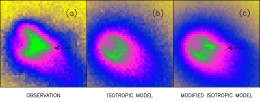In late April of this year, asteroid P/2016 G1 (PANSTARRS) was discovered streaking through space, a tail of dust extending behind it. What caused this asteroid’s dust activity?
Asteroid or Comet?

Images of asteroid P/2016 G1 at three different times: late April, late May, and mid June. The arrow in the center panel points out an asymmetric feature that can be explained if the asteroid initially ejected material in a single direction, perhaps due to an impact. [Moreno et al. 2016]
To better understand the nature and cause of this unusual asteroid’s activity, a team led by Fernando Moreno (Institute of Astrophysics of Andalusia, in Spain) performed deep observations of P/2016 G1 shortly after its discovery. The team used the 10.4-meter Great Canary Telescope to image the asteroid over the span of roughly a month and a half.
A Closer Look at P/2016 G1
P/2016 G1 lies in the inner region of the main asteroid belt, so it is unlikely to have any ices that suddenly sublimated, causing the outburst. Instead, Moreno and collaborators suggest that the asteroid’s tail may have been caused by an impact that disrupted the parent body.
To test this idea, the team used computer simulations to model their observations of P/2016 G1’s dust tail. Based on their models, they demonstrate that the asteroid was likely activated on February 10 2016 — roughly 350 days before it reached perihelion in its orbit — and its activity was a short-duration event, lasting only ~24 days. The team’s models indicate that over these 24 days, the asteroid lost around 20 million kilograms of dust, and at its maximum activity level, it was ejecting around 8 kg/s!

Comparison of the observation from late May (panel a) and two models: one in which the emission is all isotropic (panel b), and one in which the emission is initially directed (panel c). The second model better fits the observations. [Adapted from Moreno et al. 2016]
Activation By Impact
To reproduce the observed asymmetric features in the asteroid’s tail, Moreno and collaborators show that the ejected material could not have been completely isotropically emitted. Instead, the observations can be reproduced if the material was initially ejected all in the same direction (away from the Sun) at the time of the asteroid’s activation.
These conclusions support the idea that the asteroid’s parent body was impacted by another object. The initial impact caused a large ejection of material, and the subsequent activity is due to the partial or total disruption of the asteroid as a result of the impact.
To further test this model for P/2016 G1, the next step is to obtain higher-resolution and higher-sensitivity imaging (as could be provided by Hubble) of this unusual object. Such images would allow scientists to search for smaller fragments of the parent body that could remain near the dust tail.
Citation
F. Moreno et al 2016 ApJ 826 L22. doi:10.3847/2041-8205/826/2/L22


1 Comment
Pingback: Asteroid? Comet?